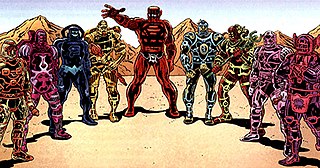Related Research Articles

Galactus is a fictional character appearing in American comic books published by Marvel Comics. Formerly a mortal man, Galactus is a cosmic entity who consumes planets to sustain his life force, and serves a functional role in the upkeep of the primary Marvel continuity. Galactus was created by Stan Lee and Jack Kirby and first appeared in the comic book Fantastic Four #48, published in March 1966.

The Marvel Universe is a fictional shared universe where the stories in most American comic book titles and other media published by Marvel Comics take place. Super-teams such as the Avengers, the X-Men, the Fantastic Four, and many Marvel superheroes live in this universe, including characters such as Spider-Man, Captain America, Iron Man, Thor, the Hulk, Ant-Man, the Wasp, Wolverine, Black Panther, Doctor Strange, Daredevil, Captain Marvel and Deadpool, among numerous others. It also contains well-known supervillains such as Doctor Doom, Magneto, Ultron, Thanos, Loki, Green Goblin, Kang the Conqueror, Red Skull, Kingpin, Doctor Octopus and Venom.

The Beyonder is a fictional cosmic entity appearing in American comic books published by Marvel Comics. Created by writer Jim Shooter and artist Mike Zeck, the Beyonder first appeared in Secret Wars #1 as an unseen, self-proclaimed omnipotent being who kidnapped the heroes and villains of the Marvel Universe and had them do battle on another planet called Battleworld.

The DC Universe (DCU) is the fictional shared universe where most stories in American comic book titles published by DC Comics take place. DC superheroes such as Superman, Batman, Wonder Woman, Martian Manhunter, The Flash, Green Lantern and Aquaman are from this universe, as well as teams such as the Justice League and the Teen Titans. It also contains well-known supervillains such as Lex Luthor, the Joker, Sinestro, Harley Quinn, Reverse-Flash, Darkseid, General Zod, Penguin, the Riddler, Catwoman, Ra’s al Ghul, Bane and Two-Face. In context, the term "DC Universe" usually refers to the main DC continuity.

Eternity is a fictional cosmic entity appearing in American comic books published by Marvel Comics. He is the de facto leader of the abstract entities collectively known as the Cosmic Powers of the Marvel Universe.

Thanos is a supervillain appearing in American comic books published by Marvel Comics. He was created by writer-artist Jim Starlin, and made his first appearance in The Invincible Iron Man #55. An Eternal–Deviant warlord from the moon Titan, Thanos is regarded as one of the most powerful beings in the Marvel Universe. He has clashed with many heroes including the Avengers, the Guardians of the Galaxy, the Fantastic Four, and the X-Men.

The Living Tribunal is a fictional cosmic entity appearing in American comic books published by Marvel Comics. The character first appeared in Strange Tales #157 and was created by Stan Lee, Marie Severin, and Herb Trimpe.

Death is a fictional character appearing in American comic books published by Marvel Comics. The character is a cosmic entity based on the personification of death. They first appeared in Captain Marvel #26 and was created by Mike Friedrich and Jim Starlin.

The Elders of the Universe are a group of supervillains appearing in American comic books published by Marvel Comics. The Collector was the first Elder to appear, and featured in The Avengers #28, but the idea that he was a member of a group known as the Elders was not introduced until The Avengers #174.

The In-Betweener is a fictional character appearing in American comic books published by Marvel Comics.

The Celestials are fictional characters appearing in American comic books published by Marvel Comics. They debuted in the Bronze Age of Comic Books and have appeared in Marvel publications for four decades. Their mythology is that they are members of the first lifeforms created in and by the original universe, and have contributed to the creation of the Multiverse present in Marvel Comics, including the evolution of life therein.

Lord Chaos is a fictional character appearing in American comic books published by Marvel Comics.

The Beyonders are a fictional enigmatic higher-dimensional race appearing in American comic books published by Marvel Comics.

Collector is a fictional character appearing in American comic books published by Marvel Comics. Created by writer Stan Lee and artist Don Heck, the character first appeared in The Avengers #28, during the Silver Age of Comic Books, and has been a recurring antagonist in various storylines over the course of the ensuing decades.

Avengers: Infinity is a four-issue American comic book limited series published from September to December 2000 by Marvel Comics. It was written by Roger Stern and drawn by Sean Chen, Scott Hanna, Steve Oliff and Troy Peteri.
Within Marvel Comics, most tales take place within the fictional Marvel Universe, which in turn is part of a larger multiverse. Starting with issues of Captain Britain, the main continuity in which most Marvel storylines take place was designated Earth-616, and the Multiverse was established as being protected by Merlyn. Each universe has a Captain Britain designated to protect its version of the British Isles. These protectors are collectively known as the Captain Britain Corps. This numerical notation was continued in the series Excalibur and other titles. Each universe of the Multiverse in Marvel also appears to be defended by a Sorcerer Supreme at nearly all times, appointed by the mystic trinity of Vishanti to defend the world against threats primarily magical in nature from within and beyond and bearing the Eye of Agamotto.
In comic books published by DC Comics, a cosmic entity is a fictional character possessing superpowers on a universal, multiversal or even omniversal level, powers far beyond those of humans or conventional superheroes, and usually serving some natural function in the fictional universe in which the entity exists.
Various divine characters have appeared in DC Comics publications over the years. This includes figures from actual mythologies and religions, as well as completely original ones.